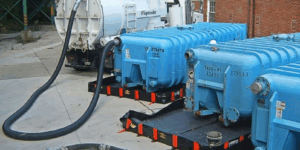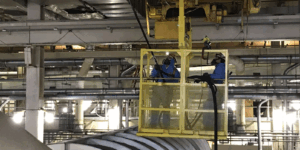Oil-water separators (OWS) are essential for industrial and commercial facilities that handle oily wastewater. Knowing how to clean an oil-water separator ensures environmental compliance, prolongs equipment life, and maintains operational efficiency. For industrial maintenance solutions, visit our homepage.
Proper cleaning and maintenance of OWS units help prevent costly downtime, regulatory penalties, and environmental hazards.
Introduction Why OWS Maintenance Matters
Oil-water separators play a critical role in separating oil, grease, and other hydrocarbons from wastewater before discharge. Regular maintenance is vital for the following reasons:
- Environmental Compliance and Safety: Untreated oily wastewater can contaminate local water bodies, leading to fines and legal issues. Proper OWS cleaning ensures compliance with environmental regulations.
- Prolonging Equipment Life: Regular cleaning prevents buildup of sludge, debris, and oil residues that can damage internal components or reduce efficiency.
- Operational Efficiency: Well-maintained separators operate at peak efficiency, reducing downtime and maintenance costs.
Understanding Oil-Water Separators
What is an Oil-Water Separator (OWS)?
An oil water separator is a device designed to remove oil and suspended solids from wastewater. It is widely used in industries such as automotive, manufacturing, chemical processing, and food production. The main goal of an OWS is to prevent oil and grease from entering sewer systems or natural water bodies.
How it Works in Industrial and Commercial Settings
Oil-water separators work on the principle of gravity separation. Oily water enters the separator, where lighter oil floats to the surface while heavier solids settle at the bottom. Internal baffles and coalescing plates enhance separation efficiency. The clean water is then discharged safely, while oil and sludge are collected for proper disposal.
Step-by-Step OWS Cleaning Process
Cleaning an oil-water separator involves multiple steps to ensure safety, compliance, and effectiveness.
1. Preparing the Area and Safety Measures
- Shut down the OWS and related equipment
- Wear personal protective equipment (PPE), including gloves, goggles, and protective clothing
- Set up spill containment and safety barriers around the work area
- Ensure proper ventilation if cleaning chemicals are used
2. Draining and Removing Accumulated Oil
- Open the drain valves to remove floating oil
- Use pumps or vacuums to extract oil from the separator surface
- Collect oil in approved containers for recycling or disposal according to environmental regulations
3. Cleaning the Separator Tanks and Baffles
- Remove sludge and sediment from the bottom of the tank using shovels, pumps, or vacuum systems
- Clean internal baffles, plates, and walls with industrial cleaners or degreasers
- Rinse thoroughly to remove residual oil and debris
4. Inspecting Filters and Internal Components
- Check coalescing plates, filter screens, and weirs for wear or damage
- Replace worn-out or clogged components to maintain separator efficiency
- Inspect gaskets, seals, and other parts for leaks or deterioration
5. Reassembling and Testing
- Reinstall all components, ensuring proper alignment and secure fittings
- Refill the separator with water to test for leaks and functionality
- Monitor the separator during the first operational cycle to ensure proper oil-water separation
Oil-Water Separator Maintenance Tips
Regular maintenance goes beyond cleaning. A well-planned maintenance routine ensures long-term performance.
Routine Inspection Schedules
- Inspect OWS units monthly for oil levels, sludge accumulation, and equipment condition
- Check inlet and outlet flows to ensure proper separation
- Document findings to track performance trends over time
Preventive Maintenance Strategies
- Remove oil and sludge before they exceed recommended levels
- Replace filters and gaskets proactively to prevent leaks
- Lubricate moving parts, if applicable, to reduce wear
Record-Keeping and Compliance
- Maintain detailed logs of cleaning, inspections, and component replacements
- Ensure compliance with environmental regulations and industry standards
- Use records for audits, reporting, and operational optimization
Maintenance Task | Frequency | Purpose |
Oil removal | Weekly or bi-weekly | Prevent oil buildup and maintain separation efficiency |
Sludge removal | Monthly | Reduce sediment accumulation and prevent blockages |
Filter inspection | Quarterly | Ensure proper filtration and replace damaged components |
Full system inspection | Annually | Evaluate overall condition and plan major maintenance |
Conclusion
Knowing how to clean an oil-water separator is essential for industrial facilities that aim to stay compliant, safe, and operationally efficient. Regular cleaning, proper maintenance, and careful monitoring protect equipment, prevent environmental hazards, and ensure smooth operation.
Implementing a proactive OWS maintenance schedule is more cost-effective than dealing with unexpected failures or regulatory penalties. For expert guidance on OWS cleaning and maintenance, explore our services page or contact us for tailored industrial solutions.
Frequently Asked Questions (FAQ)
Cleaning frequency depends on the volume of oily wastewater and sludge accumulation, but most industrial OWS units require weekly to monthly cleaning.
For safety and efficiency, it’s recommended to shut down the separator and related systems during cleaning.
Neglecting maintenance can cause reduced efficiency, equipment damage, regulatory non-compliance, and environmental contamination.
Yes, industrial oil skimmers and sludge vacuums are commonly used to safely extract oil and sediment
Yes, recovered oil can often be recycled or sent for proper disposal according to environmental regulations.







